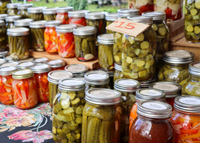There’s no one-size-fits-all for eating sustainably, but the 100-mile-diet—or eating as a locavore—comes pretty close
More of a lifestyle than a diet, eating as a locavore doesn’t restrict any food groups or products—in fact, it can actually expand your food horizons. As long as it’s been grown within a 100-mile radius of your home, it checks out.
Why people have switched to becoming “locavores”
Unlike many other diets, the 100-mile diet encourages you to only buy local food, which means you’re avoiding shipping products from thousands of miles away from you. Making this switch from eating globally to consuming more locally allows you to explore your region, what’s fresh, and appreciate what is grown right in your own backyard. It’s been undertaken by folks around the world to lower their carbon footprint.
Most food in grocery stores has to travel 1,500+ miles to reach your plate, which results in carbon emissions from trucks, planes or boats. It also means that produce has to be picked before it's ripe to ensure it can withstand the distance and the weeks on supermarket shelves, which effects the nutrients in the food.
Most commercially grown food isn’t produced with the planet or people in mind: it is an industry know for unfair labour practices, and the farming processes themselves are environmentally exploitative and overall wasteful from start to finish.
Switching to local eating has encouraged folks to reconnect with where their food comes from and who grew it. By buying right from the source, you can better control what you’re eating, and by cutting out the middle person (the grocery store), you can often save money too.
 Photo by little plant on UnsplashBenefits of eating locally
Photo by little plant on UnsplashBenefits of eating locally
- More flavourful food: Since local produce has been picked within a week or less
- Smaller environmental footprint: Less shipping, virtually no packaging and lower waste
- Better nutrition: There are more nutrients available in produce that is grown organically and harvested closer to when you’re eating it
- Diversifies your diet: Eating what’s in season encourages you to branch out and try something new
- Connects you with your land and region: Learn about what grows in your zone at any given time and foster a connection with your land through gardening on your own
- Supporting your local farming community: A little purchase goes a long way and supports sustainable farmers and growing for the future
How to start eating locally
- Start a garden and grow some food for yourself.
- Connect with local farmers in your area to buy from.
- Set a market schedule to help establish your new routine.
- Buy in season and preserve for the winter.
- Don’t forget to start small and work your way up.
- Invite others to join you, whether that’s to the market or to a locally made dinner.
The 100-mile diet will give you a new appreciation for the hard work it takes to grow—and preserve—food, it will allow you to get creative with what’s in season, plus lower your carbon footprint and support your local and sustainable farmers.

